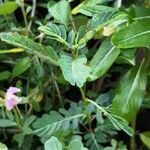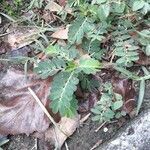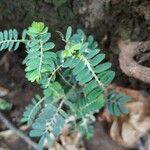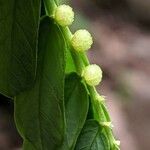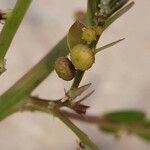Herb, usually annual, erect or procumbent, up to 5 dm high; monoecious; main stems 1-3 mm thick, subterete with narrow sharp ridges decurrent from nodes; scale-leaves on main axes scarious, 2-3 mm long. Deciduous branchlets mostly 5-10 cm long, 0.5-0.75 mm thick, with 20-35 leaves. Leaves with very short petioles; stipules unequal, the longer 0.8-1.5 mm long, lanceolate; blades mostly 8-25 mm long, 2-6(-9) mm broad, linear to oblong-obovate, obtuse or mucronulate at the tip, marginally hispidulous beneath. Cymules unisexual, the proximal nodes with solitary female flowers, the distal nodes with cymules of 5-7 male flowers. Staminate flowers with calyx-lobes 6, less than 0.5 mm long; disc-segments 6, crenulate; stamens 3, the filaments completely fused into a column, the anthers dehiscing vertically; pollen grains 4-colporate. Pistillate flowers with pedicels 0.5 mm long or less; calyx-lobes 6, linear to lanceolate, dorsally hispidulous, 0.6-0.9 mm long; disc entire or crenulate; ovary conspicu-ously papillate, the styles connate, bifid at the tips. Capsules 2-2.2 mm in diam, scurfy or nearly smooth, often reddish-blotched; seeds 1.1-1.2 mm long, light brown, with 12-15 sharp tranverse ridges on back and sides and often with 1-3 deep pits on the sides.
A herb. It keeps growing from year to year. It grows 10-30 cm high. The leaves are simple and alternate. They are 6-12 mm long by 4-6 mm wide The male flowers are in clusters in the axils of leaves. The female flowers occur singly in the lower axils. The flowers are green and cream. The fruit have 6 shallow lobes. The fruit are 2.5 mm across.
A herb with slender subwoody stems.
